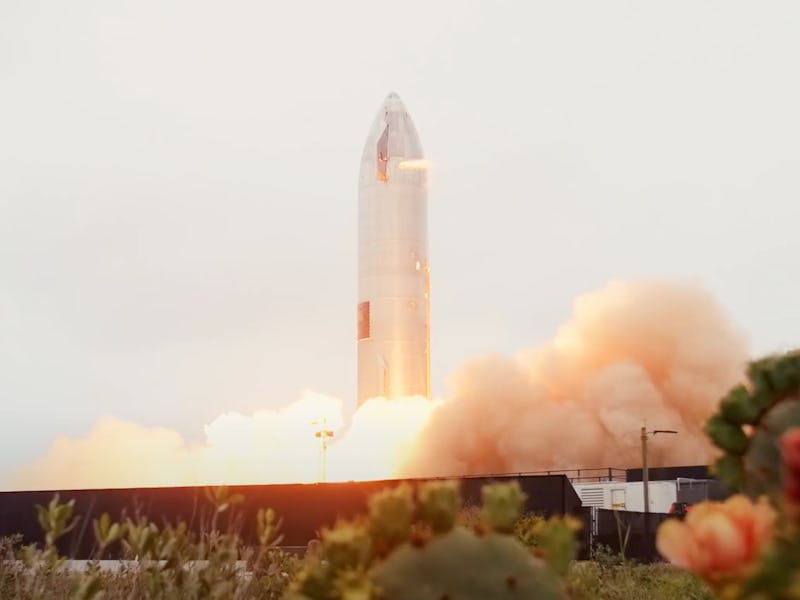SpaceX Starship SN15: slo-mo video captures jaw-dropping flight
SpaceX's Starship recently passed an impressive milestone, and the feat has now been captured in new slo-mo footage.

Liftoff! SpaceX successfully — bar a few flames — launched and landed a prototype of its Starship rocket earlier this month. A video released Tuesday has now captured SpaceX’s feat in stunning slow-motion detail.
The eight-minute slo-mo footage, produced by media team Cosmic Perspective, shows the Starship SN15 prototype during its May 5 launch. The event, held at the firm’s Texas launch site, sent the rocket to a height of around 10 kilometers (32,800 feet) before returning to Earth.
“I have so much to say about this amazing experience, it’s almost overwhelming,” MaryLiz Bender, a co-founder of Cosmic Perspective, told Inverse hours after the landing.
Want to hear more about what it was like to witness SN15 during that historic moment? Continue reading MaryLiz Bender’s account of her experience, only in MUSK READS+.
Watch the impressive video below:
The feat is an important milestone for SpaceX’s under-development rocket. The ship is designed to be fully reusable, with the ability to launch a staggering 150 tons to space at a time. The Raptor engines are powered by liquid oxygen and methane, ditching the rocket propellant used by SpaceX’s current Falcon 9 engines.
SpaceX plans to leverage these features to send the first humans to Mars and establish a base. The astronauts will land on Mars, refuel the liquid oxygen and methane tanks using the planet’s resources, and use the same ship to return home.
But before SpaceX can reach these lofty goals, it needs to perfect these Starship prototypes. The May 5 flight was the fifth high-altitude flight for the Starship:
- December 9, 2020: SN8 launched 12.5 kilometers (41,000 feet) before crashing into the ground.
- February 2, 2021: SN9 launched 10 kilometers (33,000 feet) and crashed into the ground.
- March 3, 2021: SN10 launched 10 kilometers (33,000 feet) and then landed and exploded eight minutes later.
- March 30, 2021: SN11 launched 10 kilometers (33,000 feet) and hit the ground in several pieces.
- May 5, 2021: SN15 launched 10 kilometers (33,000 feet) and landed without a hitch — except for a small fire at the base.
The Starship prototypes SN12, SN13, and SN14 never flew. As work progressed on SN15, which Musk described as a “major” upgrade, SpaceX did not finish production on the predecessors.
Where next for Starship? CEO Elon Musk claimed two days after the launch that the team may try to re-fly the ship soon. Footage captured by NASASpaceflight and shared Wednesday also showed the SN15 prototype rolling back out to the launch pad. A successful re-flight would demonstrate Starship’s reusability.
Beyond SN15, other prototypes are taking shape. NASASpaceflight reported last week that SN16, SN17, and SN20 are taking shape.
SpaceX is also constructing prototype versions of the Super Heavy booster. This addition to the Starship vehicle, which has never flown before, will add the power necessary to launch the ship from Earth into orbit. When paired together, the full construction will stand around 400 feet tall.
Beyond Mars, the ship may also take on other tasks like more traditional satellite launches. The firm has also pitched the Starship for use with NASA’s Artemis mission, which will return humans to the Moon in the coming years.
SpaceX also plans to use the ship to send Japanese billionaire Yusaku Maezawa on a trip around the Moon in 2023. Maezawa will bring with him eight members of the public, chosen via a competition.
It all starts with SN15.
TO READ MORE ABOUT WHAT IT WAS LIKE TO WITNESS STARSHIP SN15, SUBSCRIBE TO MUSK READS+.
Here is what you will gain from subscribing to MUSK READS+:
- Three emails per week, enabling fans to go deeper into the week’s news.
- Original interviews and reporting, longform analysis, previews and recaps of major events, including earnings calls and more.
- Community-focused extras like responses to reader mail, an upcoming event calendar, and notable anniversaries.
- An archive of previous subscriber-only content, so you can easily read back over what you might have missed.
- Promotional deals and offers.
- Supporting original, independent journalism.
MUSK READS+ is a fully independent operation. We are not Elon Musk, nor are we employed by him. Our job is to report the events we find newsworthy, giving you the inside look at the worlds of space rockets, electric cars, clean energy, and more. It means first-hand accounts of a SpaceX rocket launch, Tesla insights from third-party analysts, and more.
If you want to support us in our mission, and receive original interviews and analysis, consider contributing with a subscription.